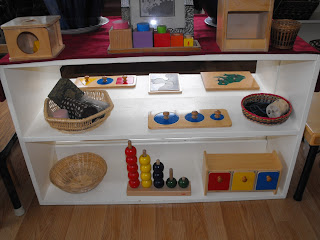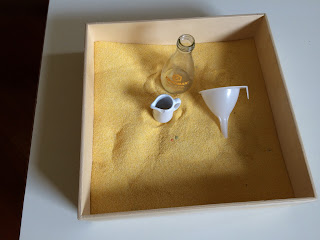Some thoughts on activities of
independent discovery
Babies of 6-9 months exploring everyday objects - DVD by Elinor Goldschmied
More
than a year has passed since the International Congress in Prague and the questions from the presentation on July 29, 2017 about
the relationship between Heuristic “Play” and Montessori “Work”
are still waiting to be answered...
As well as answering your questions in the next few weeks, I will post some thoughts by Grazia Honegger Fresco about independent discovery and the history of this combination of pedagogies here in Italy (Montessori, Emmi Pikler and Elinor Goldschmied).
People Under Three: Young children in Day Care - a book by Elinor Goldschmied and Sonia Jackson
The questions from the audience in Prague on integrating
Goldschmied and Montessori:
- I love the “heuristic play” and to watch it unfold. How does it fit into the Nido (3 months to 15 months) classroom, especially in an AMI classroom that is only to have items from the guides’ albums and trainings?
- I am an AMI Montessori trained teacher for 0-3, working in a toddler environment. In our training we learned about the standard Montessori materials, but the open ended materials I saw in the videos were not mentioned. For me, this seemed more like a play-based learning facility. I am curious about how we can integrate this kind of material in our environment.
Scooping oats to make muffins
scooping polenta activity "without a purpose"
- Could you please address the balance between sensorimotor, open, heuristic activities, and purpose driven activities of practical life, and keeping “material” order and “neatness” of the environment, especially how we introduce/present this?
- Can you please briefly guide me to find out more about the aspect about the observations regarding the genes and the stages that all the children all over the world goes through, regarding the comment by Grazia in the film Cosmic Task 0-3 “it is written in their genes”?
the treasure basket according to Elinor Goldschmied has 40-50 items
- How to understand the norm for number of materials in the toddler class? At our AMI course we were taught that large amounts of materials distract the child’s attention.
- Montessori emphasized the importance of “completion of the cycle of activity” in purposeful work. The activities of exploration (featured in the film) are purposeful, for the children’s creativity and critical thinking, but why not give them “real things” and “real work” which will accomplish the same goal and offer real life experiences that they see adults do?
but she had three glasses because at 18 months the urge is strong to pour "without a purpose" or to pour and then repeat the process - which resulted in deep concentration
- I had understood that children in 1-3 environments should not have pouring exercises or spooning exercises as these should be in the Practical Life area of 3-6, however the film showed such materials in use (not for actual drinking but as an exercise). Can you please elaborate?
Pouring water (or sand, polenta, etc) back and forth using a funnel is called travasare in Italian Montessori 0-3 and results in 20 minutes or greater periods of concentration
For
me, the question of how to integrate other work that is
evidence-based into our Montessori environments requires first fully
understanding the work others have done in their studies of the
child. Next we have to be willing to experiment and learn through
direct experience.
Elinor Goldschmied, photo from www.amicidielinor.it
Elinor
Goldschmied - the woman who came up with the “heuristic play”
activity (what we saw in the films but in a Montessori environment
and according to Montessori values) - did a lifetime of observations
and thoroughly studied how the youngest children learn. What
Elinor came to understand can be seen everywhere, in the park, in the
home, anywhere you go, if the youngest children between 12 and 20
months are allowed to explore freely. Children between these ages
will use anything they find to deposit, to insert, to manipulate, to
relate together, to transfer from here to there, to stack, to pour.
Providing collections of containers and collections of things that
can be inserted and deposited is like offering an “object
permanence box” times 1000, it is an exponential experience in
hand-eye coordination and the integration of the will, allowing for
development to be diverse, and based on each child's interest: Follow
the child.
Emmi Pikler - the inspiration behind the RIE method (Magda Gerber)
see the website: Pure Pikler
Emmi Pikler studied the progression of movement development when the child is allowed to follow his inner time table and is not assisted and helped to achieve positions, observing hundreds of orphan's and documenting what she saw. She documented that this freedom to progress in movement development produces a somatic competence and self-esteem, "I did it myself!", the ideas that Adele Costa Gnocchi and Montesssori understood through observation. Her books have not been translated into English but on the link to the website Pure Pikler (above) you can find all of her books in all of the languages they have been translated into. This is the roots of the RIE program, though they are not the same thing by any means. Magda Gerber was not formally trained by Emmi Pikler, she came to know Pikler as her child's pediatrician and later as a friend. When she emigrated to the USA she took these ideas and created an infant care program.
In 2009 in India, when I was observing at the 0-3 Montessori school after the International Montessori Congress in Chennai, I saw two boys scooping sand with a tiny cup and depositing the sand in the gaps in the cement block perimeter wall.
For 20 minutes of concentrated work time, these two boys scooped and poured and then even removed the sand in a binary activity cycle (fill/empty): purposeful work for developing concentration, hand-eye coordination, socialization, collaboration and repetition.
When I traveled three hours south of Chennai after the Congress, I went to Pondicherry where I saw a poor family, the
mother working as a street sweeper and her 2 and 4 year old children
sitting and "playing" nearby. The two year old was stacking rocks in deep
concentration.
Grazia tells me the story about her grandson as a 18 month-old, inserting coins into the VCR opening without anyone noticing, until they tried to use it and it didn't work anymore and the repair man said, “it is full of coins!”
With the materials such as the object permanence box - the younger infant takes interest in them for a while, but then the interest wains...
Grazia tells me the story about her grandson as a 18 month-old, inserting coins into the VCR opening without anyone noticing, until they tried to use it and it didn't work anymore and the repair man said, “it is full of coins!”
With the materials such as the object permanence box - the younger infant takes interest in them for a while, but then the interest wains...
The heuristic objects allow for infinite variations, so
the interest is potentially never exhausted, each child finds the ways that depositing
or stacking is most interesting to him or her and repeats that, in
deep concentration, then finds another way, using new combinations,
etc. The youngest ones do the rings on-off and the balls in-out or
discs in the slot to be retrieved from the inside of the box, but as
the infant increases his or her potential for exploratory behavior the
things that require only one kind of action are abandoned. How many
times have we seen them using the materials in the "wrong"
way and discover they have found places to deposit that we didn't
intend. An example of this as told by Valentina, an educator with
Percorsi per Crescere:
“I
had prepared an activity for infilare- a box with some colored sticks
that could be put into holes in a small wooden board, and what did
the children do? They put them into the holes in the cover of the
water turtle aquarium that we have in the room. I would put them back
and some of them would put them in there again. What was I to do? So
I let them do it and I started returning them to the box only after
they had left for home, and they could do it again the following day,
which they did. Then some time later they stopped doing it.”
In
a Montessori setting, everything we do must fit into the value system
of a prepared environment, freedom of choice, respecting the
threshold of intervention, learning from one's own activity... and we
can use these questions to measure it against these core ideas:
- Does it follow Montessori values?
- What do we see if we offer this?
- Are the children doing purposeful work?
- Are they free to choose what they do throughout the day?
- Are they following inner rhythms?
- Are they concentrated?
- Do they need to be directed, assisted often?
- Are they peaceful? Do they collaborate?
- Do they repeat their work spontaneously?
As
adults we learn from what we do, and as we all know, children learn
from what they do. Why would we offer them freedom to learn and
self-correct and not give ourselves the same?
We
have to be willing to experiment and try things out and decide what
works and what doesn't work, constantly using the guidelines set up
by Montessori: little or no intervention unless absolutely necessary,
freedom of choice, purposeful activity, concentration, repetition.
























Thank you Karin. This article resonates with my thoughts and a piece of work I wrote for my masters in early childhood education assignment.
ReplyDelete